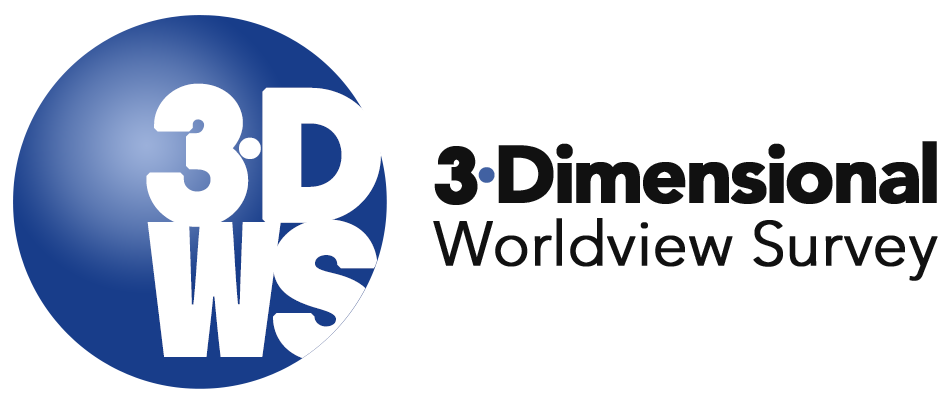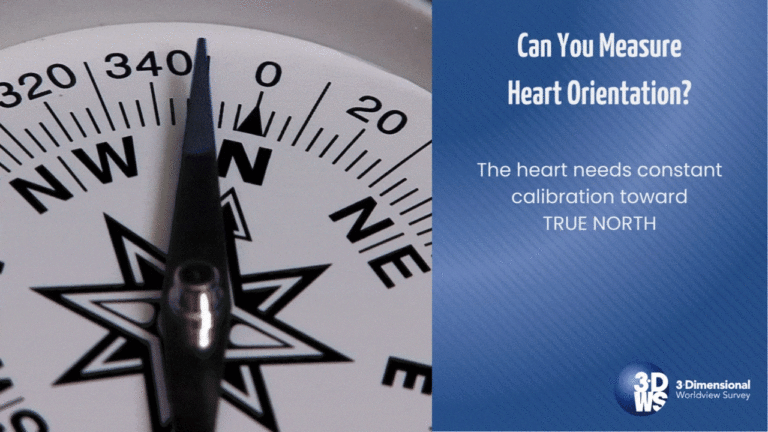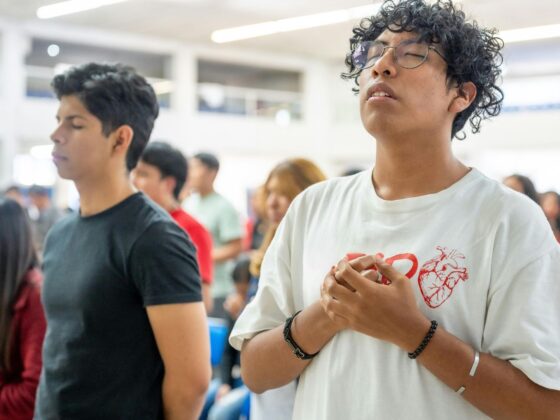Measuring Heart Orientation: Insights from Worship, Embodiment, Symbol, and Ritual
April 16, 2024
Katherine Schultz
3-Dimensional Worldview and Heart Orientation
If you’ve encountered the 3-dimensional concept of worldview in the past, you know it includes propositional beliefs, everyday behaviors, and heart orientation attitudes. When we are working with students to understand their worldview, we encounter a question often raised: Can we truly measure the orientation of one’s heart as part of their worldview? This question is not only valid but essential, especially as we work through the complex work of spiritual growth and discipleship. Rooted in the framework of a 3-dimensional worldview, let’s figure out if it’s possible to understand and measure heart orientation through the parameters of worship, embodiment, symbol, and ritual. Just as Proverbs 4:23 admonishes, “Above all else, guard your heart, for everything you do flows from it,” we recognize the pivotal role of heart orientation in shaping our beliefs, behaviors, and attitudes.
Measuring Heart Orientation Through Worship: Fundamental Expressions of Love toward God
Worship, defined as a fundamental expression of reverence and devotion toward God, stands as a cornerstone of our spiritual devotion, reflecting the posture of our hearts towards God. As we bow down in reverence before the Lord, our actions speak volumes about the orientation of our hearts. Psalm 95:6 tells us, “Come, let us bow down in worship, let us kneel before the Lord our Maker,” underscoring the profound significance of worship in shaping our heart orientation. Additionally, Psalm 100:2 further emphasizes the call to worship with gladness and joyful songs, reinforcing the importance of sincerity and joy in our worship. In essence, worship is not merely an act but a lifestyle—a continual surrender of our hearts to the One who deserves all honor and praise.
Moreover, Hebrews 10:25 encourages believers not to neglect meeting together, as is the habit of some, but to encourage one another, and all the more as you see the Day drawing near. This emphasizes the communal aspect of worship and its role in shaping our collective heart orientation towards God.
Measuring Heart Orientation through Embodiment: The Physical Expression of Heart Orientation
Embodiment serves as a tangible expression of our inner convictions. Just as Christ’s incarnation is the ultimate embodiment, our response to this truth reflects our heart orientation. Romans 12:1 exhorts believers to offer their bodies as living sacrifices, holy and pleasing to God, highlighting the inseparable link between physical and spiritual worship. And 1 Corinthians 6:19-20 reminds us that our bodies are temples of the Holy Spirit, calling us to honor God in all aspects of our lives. Whether through acts of service, stewardship of our physical health, or the expression of love towards others, our embodiment of faith is a testament to the orientation of our hearts towards God.
Furthermore, James 2:26 emphasizes that faith without works is dead. This underscores the importance of aligning our actions with our beliefs, indicating the embodiment of our heart orientation in tangible ways.
Measuring Heart Orientation through Symbols: Interpreting What Matters to Us
Symbols hold profound significance in conveying deeper spiritual truths and shaping our understanding of faith. The cross, central to Christian symbolism, serves as a clear reminder of Christ’s sacrifice and resurrection. How we reverence and engage with this symbol reflects our heart orientation towards God’s redemptive love. Additionally, Romans 6:4 underscores the symbolism of baptism, signifying our death to sin and new life in Christ. As we reflect on these symbols, may they deepen our understanding of heart orientation and inspire a deeper commitment to Christ. Moreover, our interaction with symbols extends beyond religious imagery to encompass the values, priorities, and allegiances that shape our lives. From the symbols adorning our homes to the emblems of our affiliations, each serves as a mirror reflecting the orientation of our hearts.
In addition, Colossians 3:17 urges believers to do everything in the name of the Lord Jesus, giving thanks to God the Father through him. This highlights the significance of aligning our actions and attitudes with the symbol of Christ’s authority in all aspects of our lives. And sometimes, it’s what we refuse to accept as symbolic that indicates our heart-orientation.
Measuring Heart Orientation through Rituals: Examining Practices
Rituals, both overtly sacred and traditionally secular, play a vital role in shaping and sustaining our heart orientation. Whether in religious ceremonies or daily habits, our actions reflect the orientation of our hearts towards God and others. Luke 22:19 reminds us of the significance of the ritual of communion, calling us to remember Christ’s sacrifice and partake in communion with reverence and gratitude. Likewise, our daily routines and interactions offer insights into our heart orientation, highlighting the importance of intentional living and the practices of spiritual disciplines. From the rhythm of our prayers to the habits of our hospitality, each ritual shapes our identity and reinforces our commitment to the values we hold dear.
Furthermore, Galatians 5:22-23 emphasizes the fruit of the Spirit, which includes love, joy, peace, patience, kindness, goodness, faithfulness, gentleness, and self-control. These qualities serve as indicators of our heart orientation and are cultivated through consistent spiritual practices and rituals.
Now What?
As we conclude our exploration of heart orientation through worship, embodiment, symbol, and ritual, let us embrace these parameters as integral aspects of our spiritual journey. Through self-reflection, accountability, and communal worship, may we deepen our worldview understanding, and we may grow in biblical practices that build the heart orientation we want as we orient our lives toward God daily. Let us guard our hearts diligently, allowing them to be aligned with the transformative love of Christ. As we continue to pursue a 3-dimensional biblical worldview, may we be empowered to live out our faith with authenticity and conviction, bearing witness to the transformative power of God’s love in our lives and communities.
We are convinced of the immediate relevance of developing a 3-dimensional biblical worldview in students so that they have a firm foundation of beliefs that they live out in their daily behavior as they continue with an attitude that orients their heart toward the Lord Jesus Christ throughout their lives.
- What Is the 3-D Worldview Survey?
- Take the 3-D Worldview for yourself
If you haven’t yet used the 3-D Worldview Survey with your class, check out the pdf below for some questions to get you started.
#heartorientation #biblicalworldview #assessingworldview





